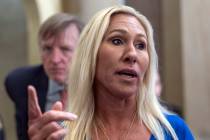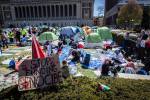EPA’s ozone rule: A cure worse than the disease
As the Environmental Protection Agency rushes to complete its new rule on ozone emissions, there's been a lot of discussion about the burdens on businesses and local governments. Yet there's been little mention of how this regulation could harm individual Americans.
For some, the effects will be all too clear. A study commissioned by the National Association of Manufacturers estimated EPA's plan to curtail ozone would destroy up to 1.4 million full-time job equivalents per year. In Nevada, more than 5,700 jobs are threatened by the EPA's expected action.
But it's not just jobs that are threatened by tighter ozone standards.
Depending on the standard set by EPA, anywhere from 1,300 to 2,000 counties around the country — up to two-thirds of all counties — won't be able to meet the ozone threshold. When that happens, those counties have to develop an action plan to tell EPA how they plan to eventually meet EPA's standard.
Unfortunately, many of the proposals will hit individual families directly.
Consider your workday commute. Most Americans commute to work in a car, generally working daytime shifts. If you happen to live in a city or county that can't meet the EPA's new ozone threshold, the price of your commute might skyrocket.
To comply with EPA's mandate, cities have considered a number of expensive new penalties on drivers, including taxes on parking spaces, tolls that get more expensive during peak congestion time and higher insurance rates for car owners who travel more miles. If you have an older car, own multiple vehicles or put a lot of miles on your car every year, you may pay higher vehicle registration fees.
What if you don't drive? The EPA can reach beyond the highway and into your backyard.
If you have a lawn that requires mowing and your town isn't meeting the EPA's ozone threshold, you could face restrictions on what time of day you rev up your weed whacker. You may also have to replace older lawn equipment, along with older air conditioning units, space heaters and water heaters — not because they don't work anymore, but because they don't meet the EPA's emission standards.
Most Americans assume EPA pollution rules target power plants and other big industries. But drastically lower ozone standards threaten all types of businesses, including farms, pharmaceutical makers, restaurants and bakeries. NAM's study estimates this wide-reaching economic impact will cost the average U.S. household $830 per year in lost consumption. That's less money for families to spend on food, housing, health care and other basic necessities.
All of this hardship might be worth bearing if it would make us healthier. We all want to breathe clean air. But the scientific evidence supporting the EPA's proposed limits just isn't there.
Environmentalists claim high childhood asthma rates justify tighter ozone restrictions. Yet ozone rates have declined by 33 percent since 1980, while asthma rates have more than doubled. The EPA also ignores the link between poverty and health — by making people poorer through increasing their energy bills and making basic necessities more expensive, those people get sicker. It's possible that the EPA's rule could actually do more harm than good to public health.
Indeed, the EPA is relying on dubious health claims to justify its ozone regulation. A number of prominent scientists and doctors have questioned the agency's scientific methodology and accused its regulators of misinterpreting and manipulating data.
Julie Goodman of Harvard and Sonja Sax, an environmental health scientist, have accused the EPA of "cherry-picking of studies," leading to "an unrealistic scenario that overestimates risks." To make matters worse, the ozone rule "would actually result in more deaths in some cities" than it prevents, according to Michael Honeycutt at the Texas Commission on Environmental Quality.
The EPA is asking American families to bear a huge economic burden, with few and dubious benefits to show for it. Federal regulators are rightfully concerned about protecting public health, but on ozone, their cure is worse than the disease.
Anastasia Swearingen is a senior research analyst for the Environmental Policy Alliance, a project of the nonprofit Center for Organizational Research and Education.























